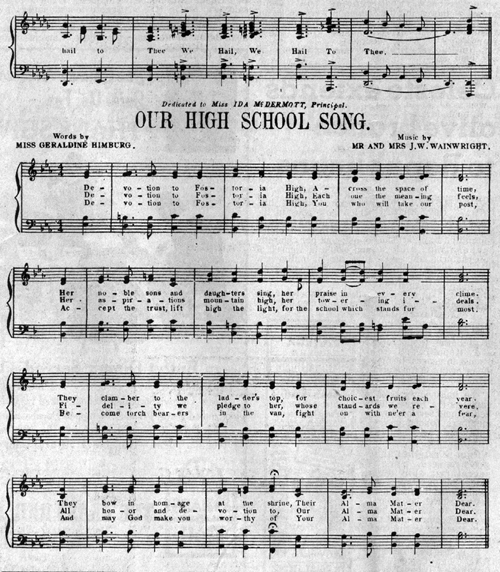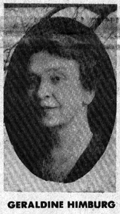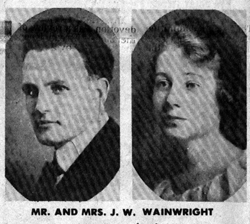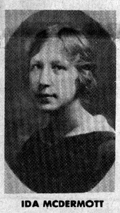November 17, 1983




Picture #1 – OUR HIGH SCHOOL SONG
Picture #2 – Geraldine Himburg
Picture #3 – Mr. and Mrs. J. W. Wainwright
Picture #4 – Ida McDermott
Sixty-four years ago Fostoria High School was given a song honoring future generations of students who entered its portals and graduated from it.
The song was for special school events, such as chapel programs, graduation exercises and athletic events. And, as the many classes graduated since then (1919), and started to return to their hometown for reunions, the song continued to be sung in honor and in memory of their alma mater.
The graduating class of FHS 1938 returned to town for a reunion a few weeks ago, and their program included singing the school song. One of those in attendance at that reunion was John F. “Jack” Prudden, M. D., from New York.
He returned home and composed a letter, confirming a telephone conversation we had about the alma mater song and his views on altering a portion of the first verse.
How many readers who graduated from FHS remember, or ever knew, the song had more than one verse? It had three verses. For that matter perhaps you do not recall that the words for the song were written by Geraldine Himburg, valedictorian, class of 1919. The music was by Mr. and Mrs. J. W. Wainwright.
HOW FHS SONG CAME TO BE
Prudden, related a story of how the song came to be, which I had never heard: Jack Wainwright dropped in at the home of Dr. and Mrs. M. A. Prudden one evening, when John F. “Jack” was just an infant. Wainwright said the school needed an alma mater song and at once sat down at the Prudden piano and picked out the melody for it. Later, he and his wife completed the orchestration, and Miss Himburg, a senior, composed the lyrics.
The new song, also a football song, written by the Wainwrights, was copyrighted in 1919, and printed appropriately in a four-page folder. The front cover showed the high school building (now Emerson Junior High); the FHS band; the student body lined up on the football field, to form the letters FHS; also the faculty. As I looked at the copy preserved at Kaubisch Memorial Public Library, I wondered how many of that printed edition are still tucked away with the memorabilia of FHS grads.
The back of the four-pager showed the band on stage; the 1919 football team; coach Weltner; Fox, captain of the team; and drum major Wayne Hughes.
1938 GRADUATE EXPRESSES VIEWS
The song is reprinted as it appeared in the original folder, so that readers can see that there were three verses; also for comparing the original first verse with Prudden’s suggested change, which follows:
Devotion to Fostoria High,
Across the space of time,
Her noble sons and daughters sing,
Her praise in every clime.
Fidelity we pledge to her,
Whose standards we revere.
All honor and devotion to
Our Alma Mater Dear.
Prudden expressed in his letter to your author his reasoning about the suggested change to the portion of the first verse:
“Since my high school reunion (Class of 1938) I have been thinking about the Fostoria alma mater, which I sang at the reunion, together with my classmates for the first time in many years! The reason for these ruminations are as follows: the afternoon of the reunion, Sydney White Dotson, her husband Matt, and I toured the superb collection of Fostoriana assembled at the Fostoria Historical Society Museum. In the course of the nostalgia, I began contemplating the High school alma mater, a print of which was exhibited there. I was astonished to see that there were three verses. I had never sung more than the first in all my school days.
THOUGHT CHANGES OVER LONG TIME
“In the past, as I had sung of my “Devotion to Fostoria High,” I had always (even in 1938) felt a faint twinge of cynicism about my classmates and I clambering to the ladder’s top for choicest fruits each year,” or really “bowing in homage at the shrine of alma mater dear,” however great my love and nostalgia for her might be!
“And, as I have traversed more and more of the space of time,’ I have become more and more skeptical over whether “choicest fruits” were something we should be clambering to the ladder’s top to get, particularly in view of the latter day implication of ‘fruits’!
“All of these occasional daydreams has led me to think idly from time to time about rewriting the second doublet of the first stanza so that it could be sung without the slightest clouding of one’s feeling of nobility by the Class of 1938, to say nothing of the present high school students, who doubtless are a much more cynical lot than we ever were, unless they have been miraculously untouched by the world’s slow stain.
“But when I saw the three stanzas which had been written by Miss Himburg, I realized that she had provided the answer herself.
“There is a remarkable prescience to the first two lines, as Miss Himburg e- quates time and space! This is clearly an intuitive leap long predating Einstein’s definitive equations! Because of this, we should leave the first two lines alone, despite the overblown use of “clime,” whose chief virtue lies in its perfect rhyme.
SPOKE LANGUAGE OF HER DAY
“It seems to me, however, that we should jettison all that Victorian hype about choicest fruits, ladders, bowing in homage; etc. which foul the last two lines of the first stanza.
“However, Miss Himburg spoke with the language of her own times. It was not her fault that the language of her day seems stilted or even phony to us many years later. Certainly there was nothing phony about her exalted idealism, as the second two lines of the second stanza demonstrate:
Fidelity we pledge to her,
whose standards we revere.
All honor and devotion to
our Alma Mater Dear.
“Now there is a finish that one can sing with the feel of truth within the heart. I think it will also pass muster with our present students.”
SUGGESTED CHANGES NOT DRASTIC
Really, what Prudden has suggested is substituting Miss Himburg’s last two lines of the original third verse to take the place of the last two lines of the first verse as originally written.
Rarely today are the second and third verses sung. So, in the opinion of this author, Prudden’s thoughts leading up to his suggestion for the slight alteration is in order. However, reader’s opinions are welcome and recommended. Frankly, I don’t know how the suggested changes can be made to become official.
Incidentally, Miss Himburg passed away about five years ago and is buried in Indiana, where her sister Ruth Galambos still resides. She taught in the Hamilton schools for many years, and during part of that time the superintendent of schools there was R. W. Solomon, previously superintendent of schools in Fostoria.
The only survivor of the trio who produced the alma mater song is Mrs. J. W. Wainwright, still residing at R.R. 1, Wolcottville, Ind. 46795.